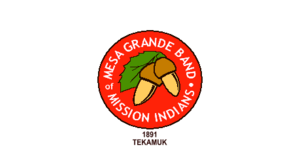Mesa Grande Band of Diegueno Mission Indians facts for kids

Flag of the Mesa Grande Band
|
|
| Total population | |
|---|---|
| 630 enrolled members | |
| Regions with significant populations | |
| United States (California) | |
| Languages | |
| Ipai, English | |
| Religion | |
| Traditional tribal religion, Christianity (Roman Catholicism) |
|
| Related ethnic groups | |
| other Kumeyaay tribes, Cocopa, Quechan, Paipai, and Kiliwa |
The Mesa Grande Band of Diegueño Mission Indians is a Native American tribe. They are part of the larger Kumeyaay people. This tribe is officially recognized by the United States government. They are sometimes called Mission Indians. This name comes from the Spanish missions built in California long ago.
Contents
The Mesa Grande Tribe
The Mesa Grande Band is a group of Kumeyaay people. The Kumeyaay are Native Americans who have lived in what is now southern California and northern Baja California for thousands of years. The Mesa Grande Band is one of several Kumeyaay tribes. They work to keep their culture and traditions alive.
What is a Federally Recognized Tribe?
A "federally recognized tribe" means the United States government has a special relationship with the tribe. This relationship is like one between two governments. It means the tribe has certain rights and powers to govern itself. This includes managing their own land and making their own laws.
Their Home: The Mesa Grande Reservation
The Mesa Grande Reservation is the official home of the Mesa Grande Band. It is a special area of land set aside for the tribe. This reservation is located in eastern San Diego County, California. It is close to a town called Santa Ysabel.
About the Reservation
The Mesa Grande Reservation was created in 1875. It covers about 1,803 acres (7.3 square kilometers) of land. Not all members of the tribe live on the reservation. About 180 of the 630 enrolled tribal members live there. In 1973, 24 out of 261 members lived on the reservation.
The Reservation in Film
The Mesa Grande Reservation was even featured in a movie! It appeared in the 1936 film called Ramona. This movie was based on a popular novel about early California.


